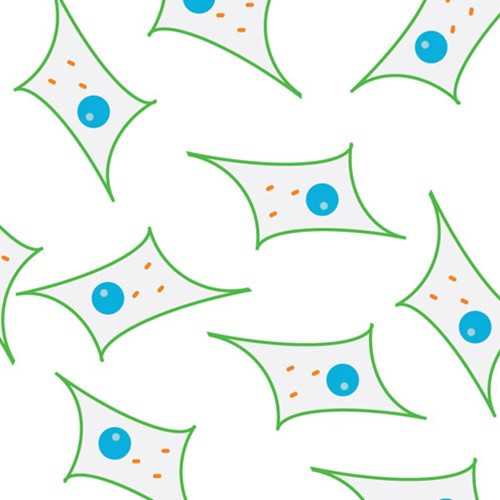Rat Suprachiasmatic Nucleus Cell Line (SCN 2.2)
Immortalized Rat Suprachiasmatic Nucleus Cells (SCN2.2) that are pluripotent and have the appearance of both neuronal and glial morphologies in culture.
Highlights:
- Capable to differentiate into different phenotypes
- Expresses the neuronal markers (NSE, PGP, and MAP-2), but absent of glial markers
- Valuable tool for studies relating to the regulation of the central mammalian pacemaker function, and the development of the suprachiasmatic nucleus (SCN) cell types
suprachiasmatic nucleus or nuclei (SCN) is a tiny region of the brain in the hypothalamus, situated directly above the optic chiasm. It is responsible for controlling circadian rhythms. Pathologies and environmental disturbances in the regulation of circadian rhythms have been linked to variety of human health disorders including obesity and diabetes, increased cancer risk, cardiovascular disease, sleep-wake cycle disturbances, and depression.
From the laboratory of David J. Earnest, PhD, Texas A&M University.
Immortalized Rat Suprachiasmatic Nucleus Cells (SCN2.2) that are pluripotent and have the appearance of both neuronal and glial morphologies in culture.
Highlights:
- Capable to differentiate into different phenotypes
- Expresses the neuronal markers (NSE, PGP, and MAP-2), but absent of glial markers
- Valuable tool for studies relating to the regulation of the central mammalian pacemaker function, and the development of the suprachiasmatic nucleus (SCN) cell types
suprachiasmatic nucleus or nuclei (SCN) is a tiny region of the brain in the hypothalamus, situated directly above the optic chiasm. It is responsible for controlling circadian rhythms. Pathologies and environmental disturbances in the regulation of circadian rhythms have been linked to variety of human health disorders including obesity and diabetes, increased cancer risk, cardiovascular disease, sleep-wake cycle disturbances, and depression.
From the laboratory of David J. Earnest, PhD, Texas A&M University.
| Product Type: | Cell Line |
| Cell Type: | Mixed Astrocytes & Neurons |
| Accession ID: | CVCL_D050 |
| Source: | Brain: Suprachiasmatic Nucleus |
| Organism: | Rat |
| Morphology: | Polymorphic |
| Biosafety Level: | BSL1 |
| Growth Conditions: | MEM (Gibco #10370) Minimal Essential Media + non-essential amino acids, 10% FBS, 0.9 ml 45% glucose per 100 ml MEM, 1 ml L-glutamine (Gibco #25030-081, 200 mM) per 100 ml MEM, Optional: 0.5 ml gentamycin (50 ug/ml, Gibco #15710-064) or 1ml pen-strep (100ug,U/ml,) |
| Subculturing: | See attached protocol |
| Cryopreservation: | Growth media w/ 7.5% DMSO |
| Storage: | Liquid nitrogen |
| Shipped: | Dry Ice |
Additional cell culture tips from the providing lab:
- When thawing the vial of cells, do so only partially in a water bath (37C) for 1-2 min and then thaw the rest of the vial with repeated transfer of warm growth media that is used to spin cells down. If thawing the cells too quickly/slowly, it may cause cell loss or damage.
- It is also important that the thawed cells are quickly centrifuged down (800-1000rpm) and plated. After centrifugation of cells (after thawing or upon passage), damage can occur if resuspension of the cell pellet is too vigorous. Dissociation of the cell pellet should be done gently with repeated pipetting. It is best to use glass, and not plastic pipettes.
- The cells should be cultured in dishes where the media layer is no more than 3mm (above cultured cells) to provide for optimal oxygen exchange.
- It is also possible to initially culture the cells on charged dishes (not laminin coated) if the goal is simply to propagate cell stock. Then once cell stock is generated, experiments can be run on laminin coated cultures.
- If dissociating cells takes longer than 5min incubation time with 0.05% Trypsin/EDTA or requires rigorous mechanical removal, then the attachment with laminin is too strong and cell viability and passage will be compromised. This may be due to the laminin lot(s) variability. The only way to address this problem is to significantly reduce the concentration of laminin that is used to coat the dishes (or request another lot from the distributor).
- Earnest DJ, Liang FQ, DiGiorgio S, Gallagher M, Harvey B, Earnest B, Seigel G. Establishment and characterization of adenoviral E1A immortalized cell lines derived from the rat suprachiasmatic nucleus. J Neurobiol. 1999 Apr;39(1):1-13.
If you publish research with this product, please let us know so we can cite your paper.


